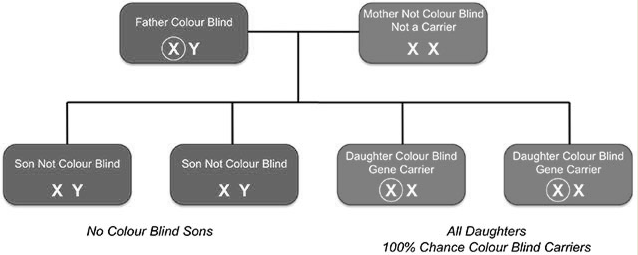
What is color blindness? Explain its inheritance with help of suitable charts.
Answer
580.8k+ views
Hint: Color blindness frequently happens when a person cannot distinguish among certain colors.
Complete answer: Colour blindness is a usually hereditary condition that means it is commonly passed down from our parents.
Red/green colour blindness is passed from mother to son on the 23rd chromosome that is called as the sex chromosome as it additionally determines sex.
Chromosomes are structures which incorporate genes; these incorporate the instructions for the development of cells, tissues and organs.
The colour blind ‘gene’ is carried on one of the X chromosomes.
Since men have only one X chromosome, if his X chromosome incorporates the colour blind ‘gene’ (X) he could be colour blind (XY). A woman could have both two normal X chromosomes, so that she cannot be colour blind or be a carrier (XX), or, one normal X and one colour blind carrying X chromosome, in which case she could be a carrier (XX), or rarely she will inherit a colour blind X from her father and a colour blind X from her mother and be colour blind herself (XX). She will pass on colour blindness to all of her sons if that is the case.

Additional information: Colour blindness is considered as recessive sex linked disease.
Its gene is located on the X - chromosome.
The colour - blind person cannot distinguish among red and green colours.
Colour blindness is more usual in male than in females.
Note: Color blindness is a genetic condition caused by a difference in how one or more of the light-sensitive cells observed within the retina of the eye respond to certain colors.
Complete answer: Colour blindness is a usually hereditary condition that means it is commonly passed down from our parents.
Red/green colour blindness is passed from mother to son on the 23rd chromosome that is called as the sex chromosome as it additionally determines sex.
Chromosomes are structures which incorporate genes; these incorporate the instructions for the development of cells, tissues and organs.
The colour blind ‘gene’ is carried on one of the X chromosomes.
Since men have only one X chromosome, if his X chromosome incorporates the colour blind ‘gene’ (X) he could be colour blind (XY). A woman could have both two normal X chromosomes, so that she cannot be colour blind or be a carrier (XX), or, one normal X and one colour blind carrying X chromosome, in which case she could be a carrier (XX), or rarely she will inherit a colour blind X from her father and a colour blind X from her mother and be colour blind herself (XX). She will pass on colour blindness to all of her sons if that is the case.

Additional information: Colour blindness is considered as recessive sex linked disease.
Its gene is located on the X - chromosome.
The colour - blind person cannot distinguish among red and green colours.
Colour blindness is more usual in male than in females.
Note: Color blindness is a genetic condition caused by a difference in how one or more of the light-sensitive cells observed within the retina of the eye respond to certain colors.
Recently Updated Pages
A man running at a speed 5 ms is viewed in the side class 12 physics CBSE

The number of solutions in x in 02pi for which sqrt class 12 maths CBSE

State and explain Hardy Weinbergs Principle class 12 biology CBSE

Write any two methods of preparation of phenol Give class 12 chemistry CBSE

Which of the following statements is wrong a Amnion class 12 biology CBSE

Differentiate between action potential and resting class 12 biology CBSE

Trending doubts
What are the major means of transport Explain each class 12 social science CBSE

Which are the Top 10 Largest Countries of the World?

Draw a labelled sketch of the human eye class 12 physics CBSE

Explain sex determination in humans with line diag class 12 biology CBSE

Explain sex determination in humans with the help of class 12 biology CBSE

Differentiate between homogeneous and heterogeneous class 12 chemistry CBSE




